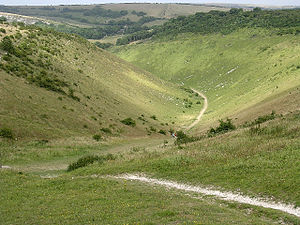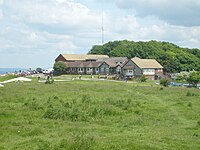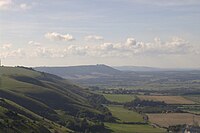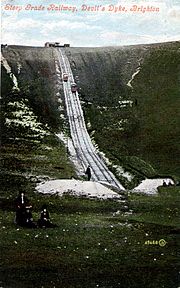Devil's Dyke, Sussex
Devil's Dyke is a V-shaped dry valley 350 feet deep in the South Downs in Sussex. It is found five miles north-west of Brighton. The valley is managed by the National Trust, and is also part of an area known as the 'Beeding Hill to Newtimber Hill Site of Special Scientific Interest'.[1]
Devil's Dyke was a major local tourist attraction in the late 19th and early 20th centuries. It is now a popular viewpoint and site for walking, model aircraft flying and hang gliding.[2] The South Downs Way passes the site.
Contents
Geological history
The Dyke is formed in rocks of the Chalk Group which originated as marine sediments during the Cretaceous period.
It is a misconception common amongst local residents of Brighton that the valley was formed by some kind of glacial action, the myth of a 'glacier' being a misunderstanding of accounts such as this one from the Encyclopaedia of Brighton by Timothy Carder (1990):
"In reality the 300-foot-deep valley was carved by tremendous amounts of water running off the Downs during the last Ice Age when large amounts of snow thawed and the frozen chalk prevented any further absorption; erosion was aided by the freeze-thaw cycle and the valley was deepened by the 'sludging' of the saturated chalk.".[3]
The V-shaped dry valley is in fact the result of solifluction and river erosion. More than fourteen thousand years ago, the area experienced an intensely cold climate (but not glacial conditions). Snowfields capped the South Downs. Permafrost conditions meant that the chalk was permanently frozen. In summer, the snowfields melted and saturated the top layer of soil, because the water could not permeate the frozen chalk underneath. Waterlogged material situated above the permafrost slid down the gradient, removing material by friction, exposing deeper layers of frozen chalk. When the Ice Age ended, the snowfields covering the South Downs melted, and rivers formed across Sussex. The Devil's Dyke valley was completed by one such river.[4]
Geography
The hills surrounding the valley rise to 712 feet and offer views of the South Downs, The Weald, and – on a clear day – the Isle of Wight in Hampshire. It is the site of ramparts, all that remain of an Iron Age hillfort, and a pub. It is a popular local beauty spot for the folk of Brighton and of Hove and neighbouring towns.
Victorian times
In late Victorian times, the Devil's Dyke became a tourist attraction, complete with a fairground, two bandstands, an observatory and a camera obscura, all served by a branchline from Hove. During its heyday, Devil's Dyke was a huge attraction for the Victorians, with 30,000 people visiting on Whit Monday in 1893.
- From 1887 to 1938 a single-track railway branch line operated from near Aldrington in Hove to The Dyke railway station, the current Dyke Farm location, to transport sightseers to the foot of the hill.
- From 1894 to 1909 a cable car operated across the valley, covering a distance of 1,150 feet, suspended 70 m above the valley floor.
- From 1897 to 1909 a 3-foot gauge narrow gauge funicular railway rose 300 feet from near Poynings to the northern edge of the hillfort.
Traces remain of all three ventures, including the remains of concrete pylon supports for the cable car system.
Folklore
Local folklore explains the dyke as the work of the Devil. The most popular form of the story begins with the conversion of the Kingdom of Sussex to Christianity. Sussex was the last of the Anglo-Saxon kingdoms to embrace the new faith, and its conversion infuriated the Devil as he thereby lost his last stronghold in England. He therefore resolved to exterminate its inhabitants by digging a trench through the South Downs so that the sea would flood through and drown the people of the Sussex Weald. The hermit Cuthman of Steyning found out about the Devil's intentions and came up with a plan to stop him. He proposed a wager - if the Devil could complete the trench in a single night he could have Cuthman's soul, but if he failed then he would have to abandon the project and leave the people of Sussex alone for good. The Devil accepted the wager and began work that night, working his way southward from Poynings toward the sea. The mounds of earth thrown up by his digging formed the nearby hills of Chanctonbury Ring, Cissbury Ring, Mount Caburn and Firle Beacon, and the Isle of Wight in the English Channel. At first Cuthman bided his time, but shortly after midnight he displayed a lit candle in his window while also startling a cock so that it would start crowing in alarm. The light and the sound of the cock crowing convinced the Devil that dawn was about to break, and thus that he had lost his wager with Cuthman. He therefore ran away in disgrace, leaving behind the unfinished trench henceforth known as Devil's Dyke.[5]
At the bottom of the Dyke are two humps, known as 'the Devil's Graves', under which the Devil and his wife are supposedly buried. Legend has it that if a person runs backwards seven times around these humps whilst holding their breath, the Devil will appear.[5]
Location
- Location map: 50°53’6"N, 0°12’18"W
Outside links
| ("Wikimedia Commons" has material about Devil's Dyke, Sussex) |
- Devil's Dyke: National Trust information
- The Devil's Dyke EXPLORED
- 'Country File' - YouTube
- Abandoned Lines and Railways
- Paragliding at the Devil's Dyke:
References
- ↑ SSSI listing and designation for Beeding Hill to Newtimber Hill
- ↑ "Facilities and access". National Trust. https://www.nationaltrust.org.uk/devils-dyke#Facilities%20and%20access. Retrieved 12 December 2021.
- ↑ "A potted history and photographic gallery - Devil's Dyke". mybrightonandhove.org.uk. http://www.mybrightonandhove.org.uk/page_id__8046_path__0p115p195p789p.aspx.
- ↑ "Alan MacKenzie - Wildlife Photographer: The Natural History of Devil's Dyke". thinkingwithpictures.blogspot.com. http://thinkingwithpictures.blogspot.com/2007/06/natural-history-of-devils-dyke.html.
- ↑ 5.0 5.1 "Devil's Dyke myths and legends". https://www.nationaltrust.org.uk/devils-dyke/features/devils-dyke-myth-and-legend.



